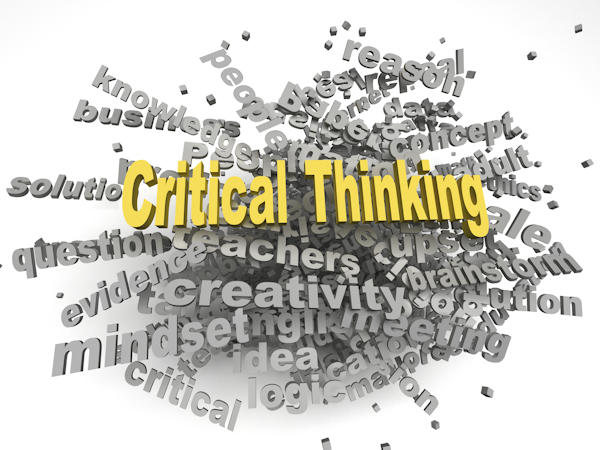Life is not a journey that can be successfully navigated using rote answers learned in school. One of the most important things any educational system can do is teach students to think critically so they are equipped to navigate life’s twisting roads. Getting children to think critically is not easy. They prefer straight-forward questions with pat answers that involve memory rather than deeper thought. As Marlana Martinelli (@Mmartinelli81) writes, “Getting students to dig deeper and answer questions using higher-level thinking can be a challenge.”[1] One of the reasons I stress the importance of science, technology, engineering, and mathematics (STEM) education is because it helps students think critically about the world. Dr. Logendra Ponniah, a member of the faculty of Arts & Social Sciences at Taylor’s University in Malaysia, cites Christopher Hitchens, who once said, “The essence of the independent mind lies not in what it thinks, but in how it thinks.”[2] Ponniah adds, “STEM education is more than just nurturing young talents to take on STEM-related careers, but rather the competency of the person that is acquired through a STEM-based education. We, as educators and parents, sometimes neglect the role of education as a way of helping young people see and make sense of the world. STEM helps young people to shape a creative and critical thinking mindset. It instills in our children intrinsic problem-solving abilities, critical thinking skills and a sense of curiosity — qualities that are of the utmost importance to readily take on the future.”
How STEM helps students think critically
Ponniah explains how each STEM subject teaches students how to think critically in a little different way. He writes:
“As children, Science became an interest to us when we realized that inquiry and critical thinking can explain various phenomena in our environment. Since its existence, technology has been integrated into a large part of our lives and has become a tool to solve numerous real-world problems covering connectivity, trading and business, healthcare, education, and many more. Engineering teaches design thinking and systematic thinking, which make for systematic thinkers and planners who can conceive engineering design principles that are widely used in many industries. Mathematics, as a subject, should introduce to students methodical, logical teaching to enable them to see patterns that form our world.“
Too often, children get bored or frustrated with STEM subjects because they are not easy, and often are not presented in fun way. For that reason, I, along with a few colleagues, founded The Project for STEM Competitiveness — a project-based, problem-solving approach to STEM education helping schools near where we live demonstrate to students that STEM subjects can be fun and applicable in their lives. We believe learning how to solve everyday problems will help students in every aspect of their lives by teaching them to think critically about how they can overcome challenges. Victoria Smith, Curriculum Director and Instructor at STEM World in Pasadena, CA, writes, “Critical thinking skills have become a top priority over recent years. Educators and employers are well aware of the importance of being able to really think, rather than just memorizing knowledge and procedures.”[3]
Helping students to think more critically
“STEM is neither a body of knowledge nor a professional engagement,” writes Ponniah, “it is a way of thinking.” Smith asks rhetorically, “Why are STEM projects a particularly effective way to develop critical thinking skills?” Her answer, “A good STEM program presents students with real problems, possibly that have not yet been solved in the ‘real world.’ This empowers students by demonstrating that they have a role to play and a contribution to make, as well as letting them know that it is not possible to simply tell them the answers. In a good STEM learning environment, the teacher acts more as a guide than as the expert with all the pre-defined answers.” Martinelli offers ten tips teachers can use to help their students become better critical thinkers. They are:
1. Give students time to think. Martinelli explains quick answers to tough questions are rarely the best answers. Give students time to think through the question before asking for responses.
2. Pose a Question of the Day. Good questions require students to think more deeply. Martinelli recommends holding an end-of-day discussion about the question of the day. This will encourage students to ponder the question during the day and consider possible answers so they can participate in the discussion.
3. Provide a response box. Martinelli explains, “Write a random critical-thinking question on the board, (e.g., Is there a better way to work out this problem? Explain your thinking.). Give students a specified amount of time to provide a written response and put it in the response box. Pull out entries one by one and read them aloud to the class.”
4. Take a side. Although the world is mostly colored in shades of gray, having students take a side when considering two opposing views helps them understand how they think about problems. Martinelli writes, “Read a statement that has two opposing views (e.g., Do you agree or disagree with the author? Why?). Ask kids who agree to stand on one side of the room and those who disagree to stand on the other side. Then have kids talk about why they chose each side. They can switch sides if they change their minds during the discussion.”
5. Ask “why?” five times. This is a very helpful technique to get to root causes of problems.
6. Role-play. Kids have great imaginations. Martinelli writes, “Come up with an imaginary scenario and have kids work through the steps to solve a problem as a class. First, identify the problem and write it as a question (e.g., Why didn’t the science experiment work as planned?). Then brainstorm ideas to solve it and choose the best one to write as a solution statement. Finally, create an action plan to carry out the solution.”
7. Go “hitchhiking”. Hitchhiking takes you on a journey. Martinelli suggests, “Practice creative thinking by collaborating on a storyboard. Write a problem on an index card and pin it on the top of a bulletin board. Then put different headings on index cards and pin them below the main card. Have kids brainstorm ideas that develop each of the heading cards and let kids pin them on the board. Encourage kids to ‘go hitchhiking’ by building onto their classmates’ ideas.”
8. Turn around. Teachers routinely are confronted by students who fail to meet expectations. Martinelli suggests turning bad situations into better ones. She explains, “A great way to focus on the positive in not-so-positive situations is the Turn Around thinking strategy. If a student forgets to bring his homework to school, you can ask, ‘What good can come of this?'” If the student provides constructive responses, turning the bad situation around, everybody wins.
9. Put your pocket chart to good use. Martinelli writes, “Choose six completed questioning stems from different levels of Bloom’s Taxonomy and put them in a pocket chart. Choose some strips as mandatory and let kids pick two from the higher levels to answer aloud or in a journal.” If you are not familiar with Bloom’s Taxonomy, here’s a brief history lesson. In 1956, Dr. Benjamin Bloom developed an interesting taxonomy he hoped would “promote higher forms of thinking in education, such as analyzing and evaluating concepts, processes, procedures, and principles, rather than just remembering facts (rote learning).”[4] The taxonomy was introduced in a volume he edited entitled Taxonomy of educational objectives: the classification of educational goals, and, according to Wikipedia, the book “remains a foundational and essential element within the educational community.” Bloom’s original taxonomy classified six categories of cognitive processes: Knowledge; Comprehension; Application; Analysis; Synthesis; and Evaluation. The idea is that as you ascend up the different categories in the taxonomy your learning becomes dramatically better.
10. Hold a Q&A session. “One way you can figure out how well kids are grasping critical-thinking skills,” Martinelli writes, “is by holding question-and-answer sessions. Ask a variety of questions one-on-one or in small groups and take note of the levels of thought individual students use regularly and avoid over time.” The onus is on the teacher to ask penetrating questions that force students to think critically.
Although Martinelli places an emphasis on teachers asking questions, Smith writes, “In STEM activities, students will be encouraged to ask their own questions and explore problems for themselves. They will come up with solutions, put them into practice, and be able to evaluate them. This gives them much-needed ‘permission’ to think independently and creatively, something that can often be stifled in other contexts, and this stretches their critical thinking.” She adds, “Critical thinking does not just prepare students for educational achievement and employment, but also helps them to function better as citizens and in their own lives. Of course, the beauty of critical thinking skills is that, no matter where they are developed, they can be applied in all areas of life, allowing us to better respond to whatever challenges arise in any context. Additionally, the confidence and self-esteem students can gain from participating in STEM projects that allow them to fully use their thinking skills, is invaluable.”
Footnotes
[1] Marlana Martinelli, “10 Tips for Teaching Kids to Be Awesome Critical Thinkers,” We Are Teachers, 7 March 2017.
[2] Logendra Ponniah, “STEM is a way of thinking,” The Star, 15 August 2017.
[3] Victoria Smith, “Developing Critical Thinking Skills Through STEM,” Pasadena Now, 26 November 2019.
[4] Donald Clark, “Bloom’s Taxonomy of Learning Domains,” Big Dog & Little Dog’s Performance Juxtaposition, 12 January 2015.





